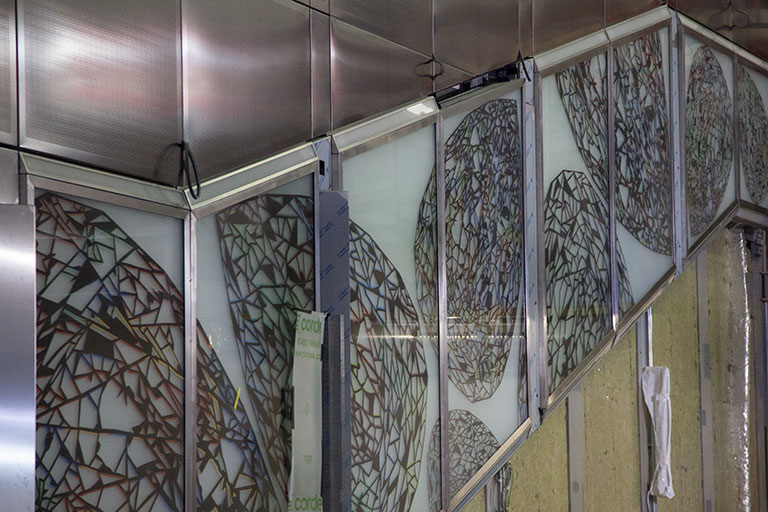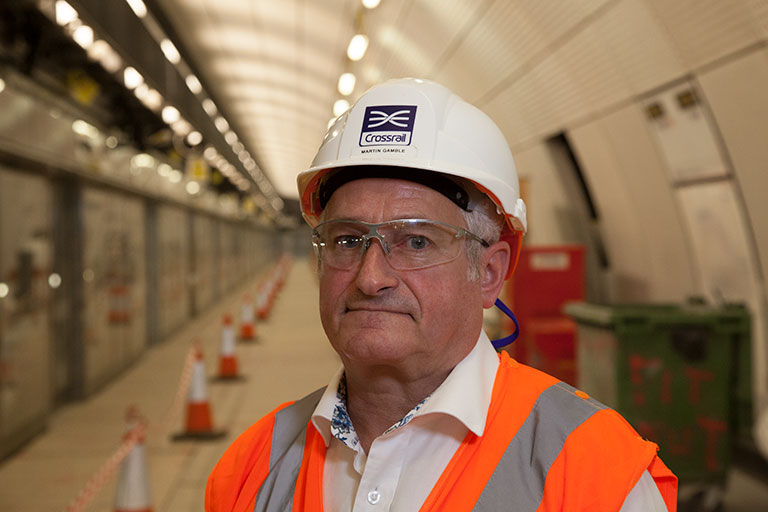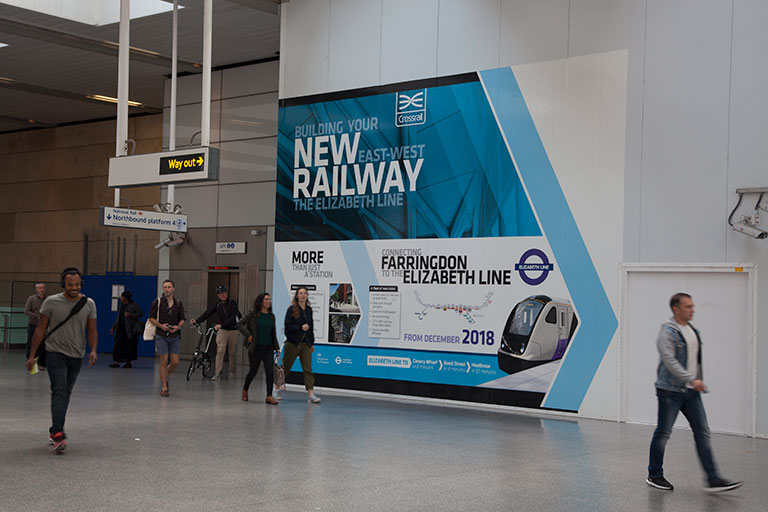Deep below London a network of tunnels that links both new-build and renovated station infrastructure marks a sea change for transport in the UK’s capital city and beyond
Crossrail’s ambitious work developing the new railway – called the Elizabeth line – represented the largest infrastructure project in Europe while it was underway. Now completed and fully integrated with the city of London’s existing transport systems, the line runs for more than 100km from Shenfield and Abbey Wood in the east, to Reading and Heathrow in the west.
Expected to add £42bn to the UK economy, the new line supports regeneration efforts across London, changing the way passengers navigate the city forever. And, from the digging of the tunnels, the construction and renovation of the stations, the laying of the track and the running of the trains, steel has played a vital role in this epic project.
The Elizabeth line serves 41 stations, with 10 of these being entirely new builds. For the existing stations that connect with the new line, 30 underwent works to upgrade them to handle the new model trains and the increased passenger volume.
Martin Gamble is construction manager for Farringdon, an existing station in the centre of the UK capital which is one of the nation’s busiest. “There’s about 42km of tunnels that we’ve built,” he says, “including 10 brand new stations in the central area of London.”
“The Elizabeth line increases by 10% the capacity of the whole London rail network,” says Gamble, adding that the new service will handle more than 200 million passengers annually.
An engineering marvel
In order to create the tunnels that allow the new Elizabeth line to weave its way under the foundations of the historic buildings and existing rail lines that honeycomb London’s underground, eight steel-built tunnel boring machines (TBMs) spent three years carving 42km worth of rail tunnels.
The new tunnels, which can reach depths of as much as 40 metres, represented a complex challenge for Crossrail and required sophisticated, modern engineering techniques to be completed safely and successfully.
“The station tunnels are around about 12 metres in diameter and we have to be very careful when we’re building that we don’t get too much settlement at the top.”
Kicking things off were the gigantic TBMs, which used their hardened steel cutting heads to carve their way through the varieties of soil density found across the city. “Some of the ground conditions, particularly here at Farringdon have been very challenging,” stresses Gamble.
Managing ‘settlement’, where the ground shifts after the boring of an underground hole, was a key part of realising Crossrail’s massive tunnelling aspect. “The station tunnels are around about 12 metres in diameter and we have to be very careful when we’re building that we don’t get too much settlement at the top.”
Ground shifts caused by tunnelling settlement can potentially damage buildings and infrastructure at surface level and this process is managed in part by using ‘compensation grouting’. Here, grout, a substance similar to cement, is inserted into ground areas with high settlement potential. Through this technique Gamble says the Crossrail team were able to “keep settlement at the surface to acceptable levels”.
A steel backbone
Due to the challenging ground conditions at Farringdon, which is deeper and wetter than other Crossrail sites, the tunnels are made of steel reinforced concrete that was cast in situ. This on-site casting was a key component of the project’s successful tunnelling strategy, and around 1,750 tonnes of sprayable concrete was deployed at Farringdon, with 12,750 tonnes of steel reinforcement bars supporting the tunnel structure.
“Everything below ground is generally in reinforced concrete,” says Gamble, adding that “where the seven-metre tunnel boring machine tunnels were expanded out to 12 metres, a sprayed concrete lining was employed”.
“Obviously, concrete is very poor in tensile strength. Having the steel there means that the strength of the concrete can be achieved very quickly.”
“Within this sprayed concrete lining are lengths of steel reinforcement which are added to the mix when the concrete is being prepared. This steel actually gets thrown directly out of the nozzle, providing the tensile strength for the primary lining when that starts going off.
“Obviously, concrete is very poor in tensile strength. Having the steel there means that the strength of the concrete can be achieved very quickly.” This technique also meant the Farringdon team could avoid the difficult process of installing steel reinforcement bars and spraying around those.
It was this steel backbone to the sprayed concrete that allowed for a quick and efficient establishment of the tunnels that allowed the rest of the project to continue.
 The glass and stainless steel panelling at Farringdon features a diamond design reflecting the nearby Hatton Garden jewellers
The glass and stainless steel panelling at Farringdon features a diamond design reflecting the nearby Hatton Garden jewellers
Station to station
The stations are also impressive in their scope, featuring expanded infrastructure to handle the new trains and increased passenger numbers, combined with a bold aesthetic that reflects the heritage of the various site areas.
At Farringdon’s western ticket hall, a 450-tonne suspended celling has been made in a diamond structure to illustrate the jewellery businesses located in nearby Hatton Garden. A massive steel structure was installed to support the construction of the ceiling, remaining in place until the permanent structure was completed.
In the eastern ticket hall, references to the nearby Barbican Centre can be seen, while both halls feature champagne coloured stainless-steel cladding and glass panelling that give the Farringdon site a light and welcoming atmosphere for London’s commuters and tourists.
The stations along the Elizabeth line have been designed so that as passengers move upwards from the tunnels to street level, each site has its own unique character, as well as offering safe, accessible and striking spaces that can be traversed easily and efficiently.
 Martin Gamble is construction manager at Crossrail’s Farringdon site
Martin Gamble is construction manager at Crossrail’s Farringdon site
Getting from A to B
On the Elizabeth line, a train runs every two and a half minutes at peak times and every platform has been refurbished to handle the fleet of new high-tech, high-capacity trains.
These trains feature between seven and nine fully interconnected walk-through carriages, increased standing room and seat type variety, as well as air conditioning. The trains also have smart lighting and temperature control and use their braking systems to regenerate electricity, resulting in a 30% reduction in energy use.
The stations have sealed stainless-steel and reinforced glass screen door units installed on the platforms, removing the tunnel through-wind and providing screens relaying information on the number of passengers in each individual carriage for incoming trains. This allows passengers to move to the section of platform corresponding to the carriages with room for them, increasing efficiency and comfort.
More than 50km of high-strength steel rails have been installed for the Elizabeth line, but again the area around the Farringdon site presented a particular challenge due to potential noise impacts.
“There are five different types of track here on Crossrail, that we’ve used,” says Gamble. “There’s the general flat track slab that you would see in most stations on the underground. In two locations, however, one under Soho, where the recording studios are, and also under the Barbican theatre, we had to use what’s called a floating track slab.
“This type of track stops vibrations from the trains moving through the tunnel then being ground-born up into the structures above. To achieve this, you build a giant flat slab that sits on massive steel springs. This slab supports the track and the springs dampen the vibrations so that when you’re listening to your Rachmaninoff in the Barbican you won’t hear the sound of the rumbling underneath your feet.”
 Passengers walk past a sign outlining the new Elizabeth line railway
Passengers walk past a sign outlining the new Elizabeth line railway
A lasting impact
Now the Crossrail project has been completed and the Elizabeth line is up and running, more than 1.5 million people have access to the centre of London in a journey time of less than 45 minutes. The system also makes travel across the city simpler and more efficient, easing congestion on London’s crowded transport networks.
The improved transport links between the city’s major business and financial districts and the major airport of Heathrow give commerce a vital boost, with the overall benefit to the UK’s economy expected to reach £42bn.
“Everything on Crossrail is built for a 120-year design life and steel plays into this”
The project’s societal and environmental impacts have been a key consideration, with many of the materials used being sourced as locally as possible, including 2,500 tonnes of structural steel and 2,750 tonnes used in the site’s temporary works, while reuse of materials was central to the planning of the excavation phase.
“Any spare steel and some of the props that were cut out were taken away and recycled,” says Gamble, who adds that about 99% of all the materials used at Farringdon were reused.
“Everything on Crossrail is built for a 120-year design life and steel plays into this. Having things installed for such a long time and not being recycled was a key aspect, making sure that you build it once and it stays up.”
With such a large-scale project, the choice of materials can influence the success of every phase and by choosing steel Crossrail is ensuring the longevity and sustainability of the Elizabeth line and the future of London’s transport networks.
Images: Crossrail, iStock
Video: Crossrail, Specialist